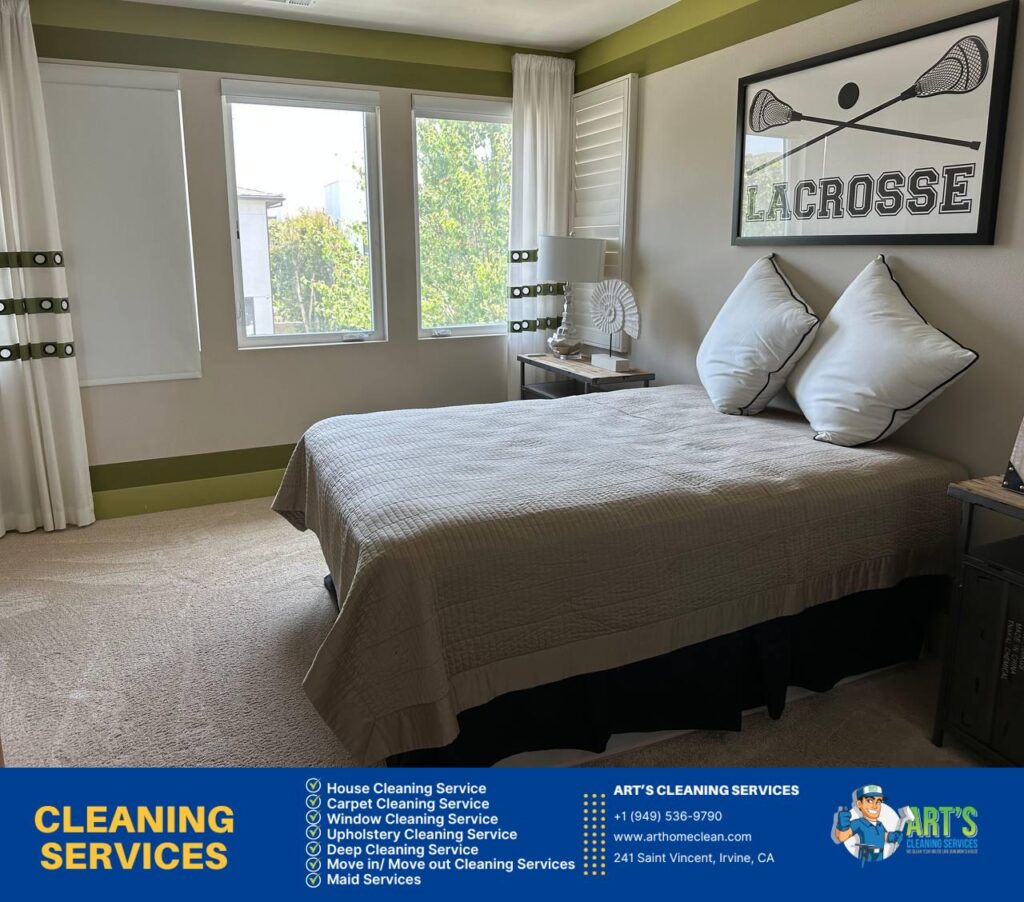
Upholstery Cleaning Services by Art’s Cleaning Services
Your furniture works hard every day – it deserves more than a quick vacuum. Art’s Cleaning Services provides deep fabric-safe upholstery cleaning services that eliminate dirt and odors and allergens and stains from sofas chairs sectionals and additional furniture pieces. Our team at Art’s Cleaning Services provides safe and effective upholstery cleaning services that restore your furniture to its original appearance without causing any damage.
Top Rated Upholstery Cleaning Services
★★★★★
5-Star Rated
Your 5-Star Rated Upholstery Cleaning Services
Art’s Home Cleaning Services is a 5-Star rated cleaning company in CA. We take pride in our professional and customer-focused approach to residential and commercial cleaning, making sure that every customer is satisfied with our results. We use top-of-the-line cleaning products and cleaning supplies to ensure that your house or office cleaning meets the highest standards. Art’s House Cleaning Services also offers pet stain removal and deodorizing services to ensure that carpets are kept looking and smelling great.
With years of experience in the industry, we can provide the best results!
Why Homeowners Choose Art’s for Upholstery Cleaning
A couch represents more than mere furniture since it serves as the central hub of household activities. We treat every piece like it matters.
Fabric-Safe Techniques
Our testing procedure precedes treatment operations which we execute with caution.
Professional Equipment
We perform cleaning operations using industrial-grade steam extraction tools and specialized brushes.
Flexible Options
The decision regarding furniture cleaning depends on whether you want spot cleaning or a full cleaning of your sets or maintenance visits.
Fast Dry Times
We apply moisture-control methods that result in fast furniture drying times.
Your home becomes healthier and more inviting and fresh when you keep your furniture clean.
Deep Fabric Cleaning, Without the Risk
To maintain proper upholstery care one must execute deep cleaning procedures that avoid material damage while preventing saturation. Our team possesses expertise which allows us to select appropriate cleaning solutions based on fabric types. Our professionals extract dirt together with sweat and allergens and odors at their origin point and prevent both water saturation and residue formation.
Your furniture will emerge fresh and clean while maintaining its original appearance and texture.

What’s Included in Our Upholstery Cleaning Service
Our service covers all types of upholstered furniture including compact chairs and extensive sectionals.
Our service includes:
- Pre-inspection and fabric testing
- Pre-treatment of stains and heavily used areas
- Deep cleaning with steam or low-moisture methods
- Deodorizing and optional pet odor removal
- Final grooming and quick-dry finish
We clean:
- Sofas & loveseats
- Armchairs & recliners
- Dining chairs & benches
- Sectionals & ottomans
- Headboards & more
Do you have doubts about your fabric type? We will identify it after receiving a photo from you.
Clean Furniture = Cleaner Living
You maintain your floor vacuuming schedule yet your couch remains unclean since its last washing. All substances from human skin oils and pet hair and food particles and allergens find their way into upholstery materials. Prolonged accumulation of these substances creates problems which affect both visual quality and indoor air purity as well as comfort levels.
Our cleaning process delivers multiple advantages:
- Fabric softness and texture
- Appearance and color vibrancy
- Odor control and freshness
- Overall home cleanliness and health
- Breathe better. Sit cleaner. Feel more at home.
Our Step-by-Step Furniture Cleaning Process
We make it easy. Our team will take care of your furniture cleaning requirements after you specify which items need cleaning.
Each cleaning includes:
- Arrival with protective materials and tools
- Fabric inspection and spot testing
- Safe, deep cleaning based on fabric type
- Stain removal and deodorizing
- Final check and drying guidance
The majority of cleaned pieces become available for use during a time span of several hours. No mess. No hassle.
Our Services
We Offer More Than Just Upholstery Cleaning Service
Our motto is “cleaning made easy.“
We want you to enjoy the benefits of a clean home without having to worry about how – we’ll get it done for you.

House Cleaning
Our house cleaning service provides you with a clean, odor-free, and welcoming home without the hassle. We thoroughly clean every area of your home including bedrooms and living rooms as well as kitchens and bathrooms with attention to detail.

Carpet Cleaning
Our carpet cleaning service is perfect for removing built-up dirt, dust, and stains that standard vacuuming can’t reach. Our deep-cleaning method removes odors and lifts debris to make your carpets fresh, clean, and revitalized.

Move In Cleaning
Our move-in cleaning service prepares your new space for a fresh beginning. Our cleaning process includes complete sanitizing of floors and baseboards and inside cabinets so you can move in with confidence and comfort.

Move Out Cleaning
Our move-out cleaning service provides you with a stress-free way to leave your home perfectly clean. Our team performs deep cleaning of appliances and bathrooms and kitchens and floors to achieve perfect condition for the next resident.

Deep Cleaning
The service focuses on removing dirt that standard cleaning methods fail to detect. Our cleaning service focuses on baseboards and inside cabinets and detailed areas to provide your home with a complete transformation. The service is perfect for seasonal cleaning needs and post-renovation property resets.

Vacation Rental Cleaning
Our cleaning process for vacation rentals reaches hotel standards between guest stays. Our team maintains bathrooms to a sparkling state while providing clean linens and spotless floors which results in 5-star reviews from your guests.

Upholstery Cleaning
The appearance of furniture stains does not need to be permanent. Our upholstery cleaning service removes stains and spills efficiently and safely to maintain the fresh appearance and soft texture of your sofas and chairs.

Regular Cleaning
Our recurring cleaning service keeps your home tidy and smelling fresh. Our cleaning service includes dusting, vacuuming, mopping and surface wiping to keep your space in top shape without disrupting your routine.

Maid Service
Our maid service provides complete home cleaning services that allow you to relax in your perfectly clean home without any effort. Our maid service takes care of all daily tasks including kitchen and bathroom cleaning and bed making so you can return home to a peaceful environment.

Solar Panel Cleaning
Our professional solar panel cleaning service will help you keep your solar system operating at peak efficiency. Our team removes all dust and debris and buildup to maximize sunlight exposure and extend the lifespan of your solar system.

Post Construction Cleaning
We take care of the mess after renovation or building projects. Our post-construction cleaning service removes dust and debris and residue from floors walls and fixtures to make your space clean and ready for use.

Apartment Cleaning
The service is ideal for people who live in apartments and want their space to be clean without having to do much work. Our team will thoroughly clean all areas of your apartment including bathroom floors and kitchen counters to provide you with a fresh and sanitized and organized space.

Window Cleaning
Streak-free window cleaning will help you achieve a brighter home by cleaning both interior and exterior glass surfaces and screens and sills to bring back the light.

Same Day Cleaning
Our same-day cleaning service provides immediate assistance for unexpected messes and guest arrivals and emergency situations. Our service delivers fast and thorough and reliable cleaning at the moment you require it most.

Tile Cleaning
The accumulation of dirt and grime in grout lines creates an unappealing appearance on your floors. Our tile cleaning service provides a complete restoration of your flooring through the removal of buildup and surface brightening to create a cleaner healthier home environment.

100% guaranteed
Check Out Our Amazing Cleaning Results!



Ready to Schedule Your Cleaning?
2,137+
Houses cleaned
198+
Couches and Chairs Cleaned
1258+
Carpets Cleaned
Trusted by Families, Property Managers & Design Lovers
The maintenance of your furniture requires attention no matter if you have children and pets or guests or simply refined tastes. Our service caters to families with young children as well as Airbnb property managers and design enthusiasts who want perfect-looking and feeling spaces.
Our reputation stems from dependable service and exceptional results coupled with expert handling of all fabrics every time. We are available to handle any cleaning needs beyond the capability of lint rollers.

Our Experience
Our house cleaners employ advanced techniques and use the best chemical and natural agents for all your cleaning needs. These are completely safe for your skin because they don’t contain any harmful chemicals or toxic compounds! We also make sure to use professional equipment that is designed specifically for cleaning your home or business.

High-Quality Service
Our commitment to high quality starts with our rigorous background checks for every house cleaner, ensuring your safety and peace of mind. For more than 10+ years, we have been making houses and offices cleaner, people happier, and business owners more successful!

Our Cleaning Solutions
Our House cleaning service is focused on carpets, rugs, upholstery, and windows cleaning and we are proud to provide you with squeaky clean home, excellent customer service, quick turnarounds, and a smile.

Our Guarantee
We know that when our cleaning crews are on time, efficient and professional – it’s just one more way of showing how much your business matters! Whether you require a one-time house cleaning, such as move-in/move-out cleaning in Irvine, CA, scheduled house cleaning, or a same day service, you can trust us to make your home cleaner and create a healthier, more comfortable and stress free living environment for you and your loved ones.
Frequently Asked Questions
How long does it take to clean a sofa?
Most sofas take 45-75 minutes depending on size and condition.
Will the fabric be wet afterward?
Lightly. We use low-moisture systems that dry in a few hours.
Can you remove pet stains and smells?
Yes – we offer targeted enzyme treatments for odor and stain removal.
Do you clean leather or suede?
We clean most fabric upholstery. For leather or specialty materials, please contact us first.








